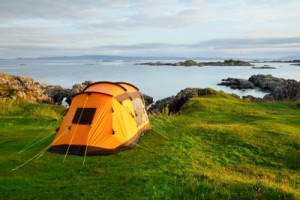 Camping tents come in many shapes and sizes. As in any outdoor activity, choosing the style and variety will most likely be determined by your specific needs and the area of the country where you plan on camping.
Camping tents come in many shapes and sizes. As in any outdoor activity, choosing the style and variety will most likely be determined by your specific needs and the area of the country where you plan on camping.
There are cabin-style tents that are upright. Generally speaking, these have the easiest in and out access. The vertical walls create an abundance of livable space. Some come equipped with room dividers and awnings. There are also dome-style tents that offer superior strength and wind-shedding abilities. These are particularly valuable on stormy nights. They stand tall but the walls are sloped which can reduce the living space.
There are some tents that are simply screen rooms or sun shelters which are designed to cover picnic tables or pitched for a day at the beach. They can be utilized as sleeping shelters but don’t offer as much shelter. These are more economical and portable and used more for shade.
As is often the case, you get what you pay for. In calm weather, a bargain tent may serve you just fine—for a while. The real difference is the quality of materials, which tends to become apparent in bad weather or after your first few outings. There are things to keep in mind if you are looking for durability and quality. Tents have poles. Aluminum is stronger than fiberglass. Check the zipper quality. The material the tent is made of is important. A higher-denier fabric canopy is rugged and durable. There are certain types of loops that are optional but allow you to batten down the hatches in bad weather and certainly worth paying for.
All in all, if camping is an annual activity for you and your group, consider the long term advantages of having a quality tent. If your camping will be in areas where there is a possibility of wind and storms, consider the additional features that will allow you to weather the storm. Other features you should consider when purchasing a tent are headroom, ease of set up and ease of access. If you like being able to stand up in your tent, look for a tall peak height. Does the tent have one door or two? What is the shape of the door? How easy is it to zip open or shut? A tent’s pole structure usually determines how easy or hard it is to pitch. Fewer poles allow faster setups. It’s also easier to attach poles to clips than it is to thread them through “continuous” pole sleeves. Many tents offer a combination of both clips and short pole sleeves in an effort to balance strength, ventilation and setup ease. Another thing to consider when purchasing a tent is the size of the tent when packed? Small-car and motorcycle campers find this spec especially important.
Virtually all family tents these days are freestanding. This means they do not require stakes to set up. The big advantage of this is that you can pick up a freestanding tent (like a huge beach ball) and move it to a different location prior to staking. You can also easily shake it out before you take it down.
Buying a tent can be similar to buying a car. The features you choose should be suitable to your needs and wants. The tent will be your shelter from the storm and your home away from home.
Source: “Tents for Camping: How to Choose”. Web. 28 Jan. 2013.
Follow Us: Facebook – Foursquare – Twitter – YouTube – LinkedIn
